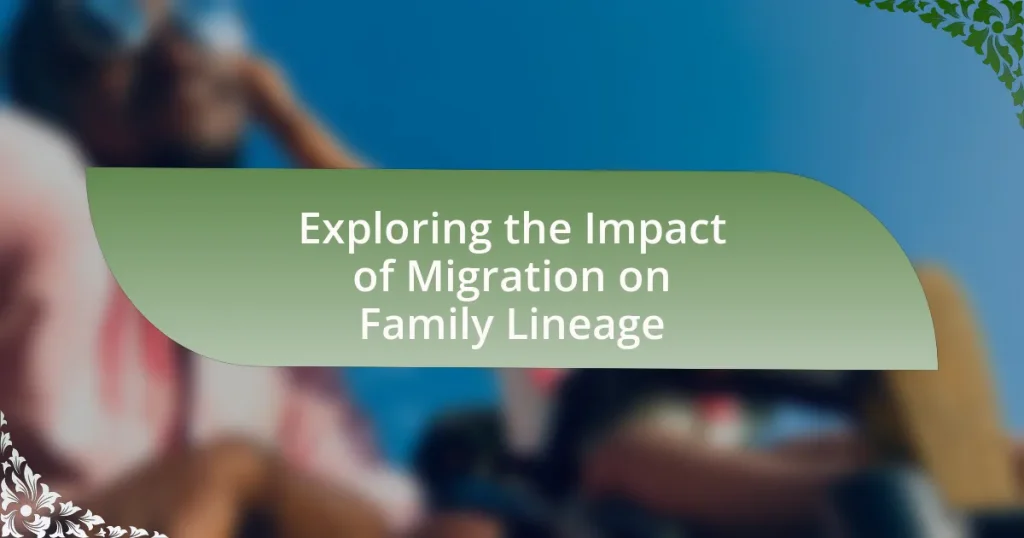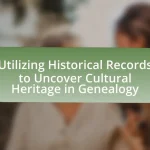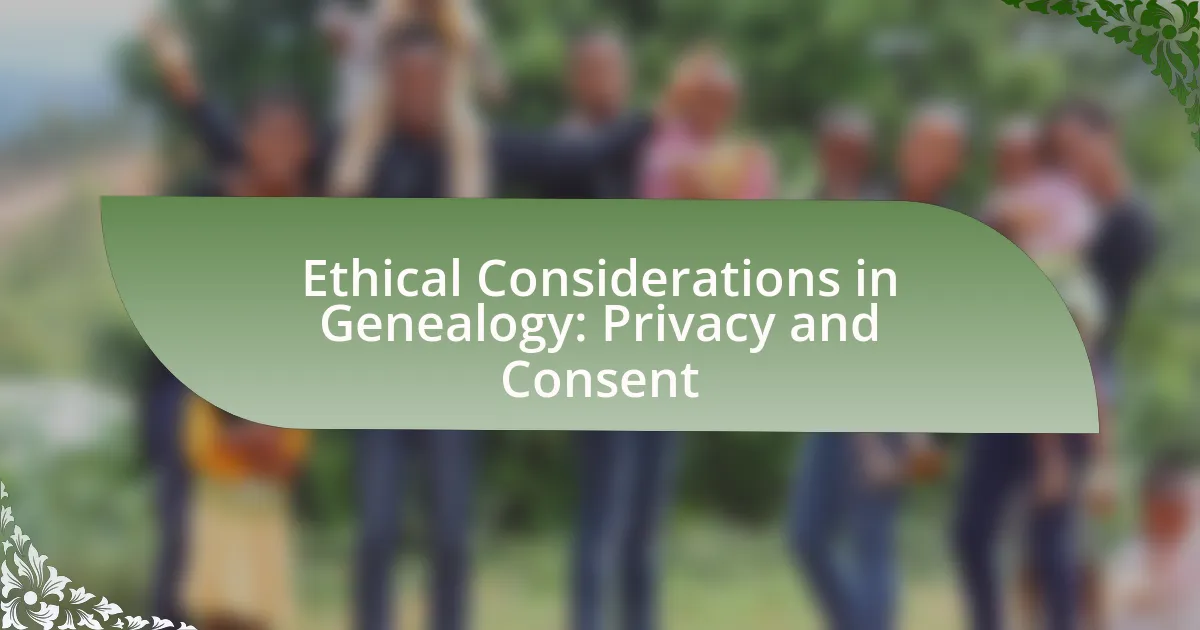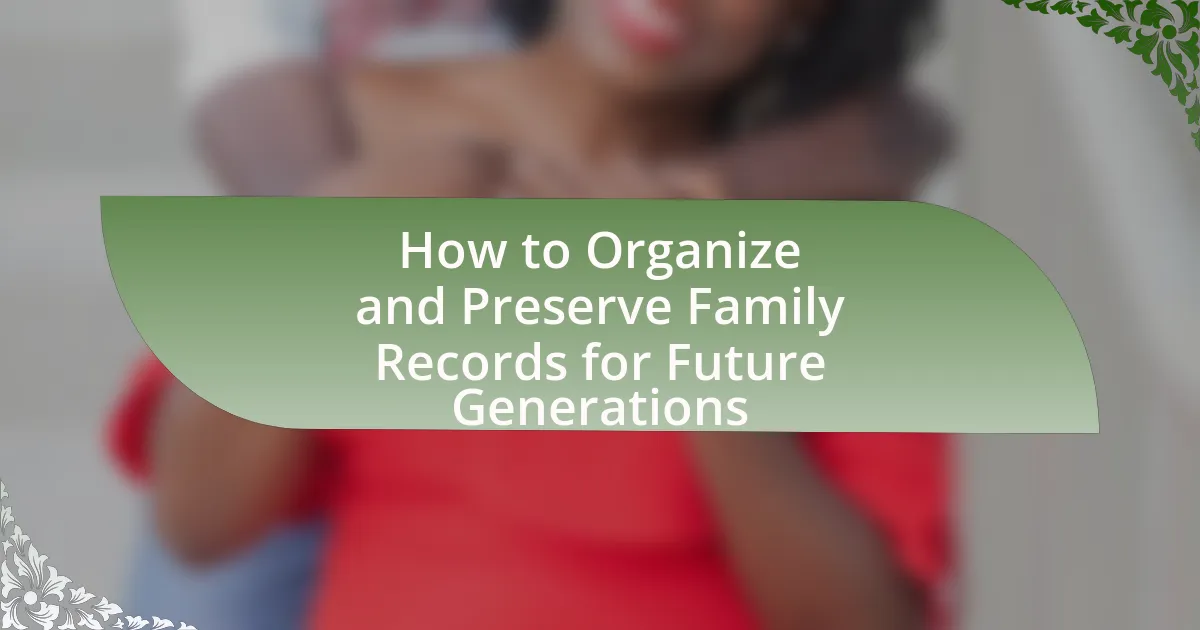The article examines the impact of migration on family lineage, highlighting how migration introduces new cultural, social, and genetic influences that reshape family structures and roles. It discusses the effects of migration on family dynamics, communication, and the preservation of cultural identity, emphasizing the differences between voluntary and involuntary migrations. Additionally, the article explores the challenges families face in maintaining lineage across borders and offers strategies for adapting to these changes, including the importance of open communication, cultural engagement, and community support. Understanding these dynamics is crucial for recognizing the evolving nature of family lineage in a globalized world.
What is the impact of migration on family lineage?

Migration significantly alters family lineage by introducing new cultural, social, and genetic influences. When individuals or families migrate, they often intermarry with local populations, leading to a diversification of genetic traits and cultural practices within the lineage. For instance, studies have shown that migration can result in the blending of languages, traditions, and family structures, which can reshape identity and heritage over generations. Additionally, migration patterns can affect inheritance practices and family roles, as seen in various immigrant communities where traditional norms may adapt to new environments. This dynamic interaction ultimately influences the continuity and evolution of family lineage across generations.
How does migration influence family structures?
Migration significantly influences family structures by altering traditional roles, relationships, and living arrangements. When individuals migrate, often for economic opportunities, family members may become separated, leading to changes in dynamics such as single-parent households or extended family living together. Research indicates that in many cases, remittances sent back home by migrant workers can support families financially, but they may also create dependency and shift power dynamics within the household. For instance, a study by the International Organization for Migration found that migration can lead to increased autonomy for women, as they may take on roles traditionally held by men in the absence of male family members. Thus, migration reshapes family structures by introducing new economic roles, altering power dynamics, and sometimes leading to emotional challenges due to separation.
What changes occur in family roles due to migration?
Migration leads to significant changes in family roles, often resulting in a reconfiguration of responsibilities and dynamics within the family unit. For instance, when one or more family members migrate for work, the remaining members may take on additional responsibilities, such as managing household tasks or providing financial support. This shift can empower women, who may assume roles traditionally held by men, thereby altering gender dynamics within the family. Research indicates that in many migrant families, children may also take on adult responsibilities, such as caring for younger siblings or contributing to household income, which can accelerate their maturity and independence. These changes reflect the adaptive strategies families employ to cope with the challenges and opportunities presented by migration.
How does migration affect family communication and relationships?
Migration significantly alters family communication and relationships by introducing physical distance and cultural differences. Families often experience challenges in maintaining regular contact due to time zone differences and varying schedules, which can lead to feelings of isolation among members. Additionally, cultural adaptation can create generational gaps in values and communication styles, further complicating interactions. Research indicates that families who migrate may rely more on digital communication methods, such as video calls and messaging apps, to bridge the gap, but these methods may not fully replicate the emotional connection of face-to-face interactions. Studies show that these dynamics can lead to both strengthened bonds through shared experiences and increased tensions due to misunderstandings or differing expectations.
Why is understanding migration’s impact on lineage important?
Understanding migration’s impact on lineage is important because it reveals how historical movements of people shape genetic diversity, cultural heritage, and social structures within families. Migration influences the distribution of genetic traits and can lead to the mixing of different lineages, which is essential for studying ancestry and health predispositions. For instance, research shows that migration patterns can affect the prevalence of certain genetic disorders in specific populations, highlighting the need for understanding these dynamics in medical genetics and public health.
What historical contexts shape the understanding of migration and lineage?
Historical contexts that shape the understanding of migration and lineage include colonialism, industrialization, and globalization. Colonialism often resulted in forced migrations, altering family structures and lineages as indigenous populations were displaced and mixed with colonizers. Industrialization led to mass urban migration, changing traditional family roles and lineage ties as people moved for work opportunities. Globalization has facilitated transnational migration, creating complex family networks that span multiple countries, thus redefining lineage in a global context. These historical factors illustrate how migration influences familial connections and identity across generations.
How do cultural perceptions of lineage change with migration?
Cultural perceptions of lineage change with migration as individuals adapt to new social environments and cultural norms. Migration often leads to a blending of traditions, where the importance of lineage may shift from strict adherence to ancestral lines to a more fluid understanding of identity that incorporates diverse influences. For example, in multicultural societies, individuals may prioritize personal achievements and relationships over traditional lineage, reflecting a broader acceptance of varied family structures. This shift is supported by studies indicating that migrant communities often redefine familial roles and connections, emphasizing chosen families and community ties rather than solely biological lineage.
What are the different types of migration affecting family lineage?
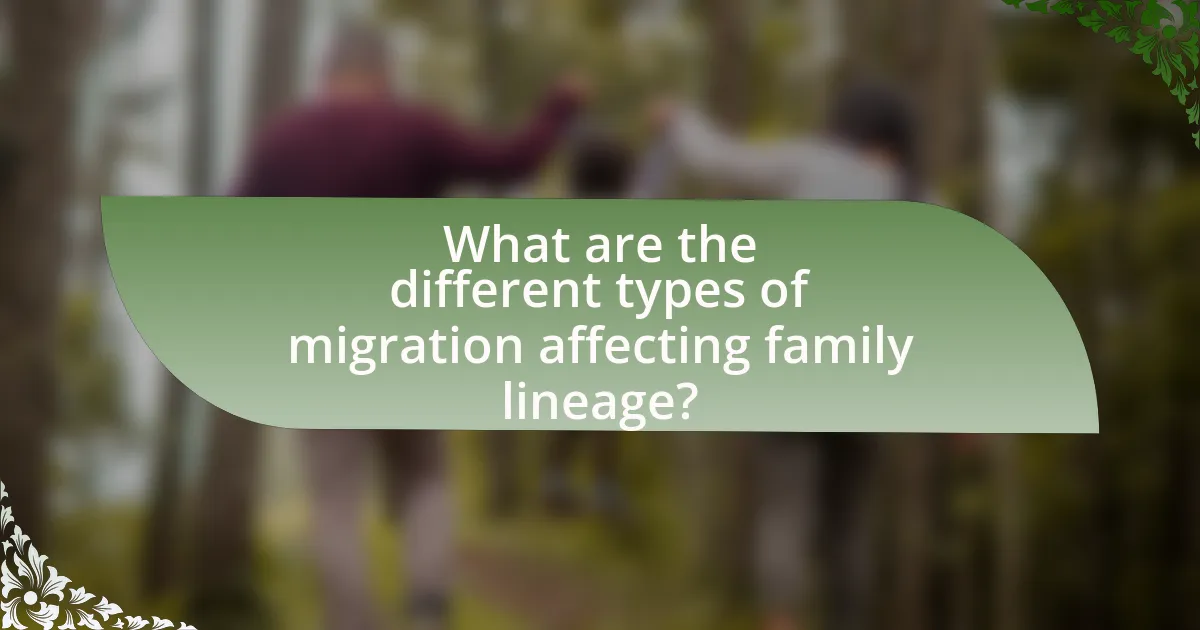
The different types of migration affecting family lineage include internal migration, international migration, seasonal migration, and forced migration. Internal migration refers to the movement of individuals within a country, which can lead to changes in family structures and lineage due to urbanization or rural-to-urban shifts. International migration involves individuals moving across national borders, often resulting in the blending of cultures and the establishment of transnational families. Seasonal migration occurs when individuals move temporarily for work, impacting family dynamics and lineage continuity during their absence. Forced migration, such as that caused by conflict or natural disasters, can disrupt family lineage by displacing individuals and altering traditional family structures. Each type of migration has distinct implications for family lineage, influencing social ties, cultural practices, and demographic patterns.
How do voluntary and involuntary migrations differ in their impact?
Voluntary migrations typically result in positive impacts on family lineage, such as improved economic opportunities and enhanced social networks, while involuntary migrations often lead to negative consequences, including trauma and disruption of familial ties. For instance, voluntary migrants may choose to relocate for better job prospects, which can lead to increased financial stability and the ability to support extended family members. In contrast, involuntary migrants, such as refugees fleeing conflict, frequently experience loss of community and cultural dislocation, which can sever intergenerational connections and hinder the transmission of cultural heritage. Studies indicate that voluntary migration can enhance social mobility, whereas involuntary migration often correlates with long-term psychological and social challenges for affected families.
What are the effects of economic migration on family lineage?
Economic migration significantly alters family lineage by creating new familial structures and altering traditional roles. When individuals migrate for economic opportunities, they often leave behind their immediate family, which can lead to changes in family dynamics and lineage continuity. For instance, studies show that remittances sent back home can support extended family members, thereby reinforcing ties but also shifting the lineage focus from the immediate family to a broader network. Additionally, the migration of one generation can lead to cultural assimilation in the host country, affecting the transmission of cultural values and practices to subsequent generations. This phenomenon has been documented in various research studies, such as the “Impact of Migration on Family Structures” by the International Organization for Migration, which highlights how economic migration reshapes family roles and lineage connections across generations.
How does forced migration, such as refugees, alter family structures?
Forced migration, such as that experienced by refugees, significantly alters family structures by often leading to the separation of family members and the reconfiguration of roles within the family unit. When individuals flee conflict or persecution, they may leave behind spouses, children, or elderly relatives, resulting in fragmented family units. Research indicates that approximately 50% of refugees are children, which can shift caregiving responsibilities and alter traditional family dynamics (UNHCR, 2021). Additionally, the stress of displacement can lead to changes in authority and decision-making roles, as surviving family members must adapt to new environments and challenges. This restructuring can impact emotional well-being and social cohesion within families, as they navigate the complexities of resettlement and integration into host communities.
What role does international migration play in family lineage?
International migration significantly influences family lineage by altering genetic, cultural, and social connections across generations. When individuals migrate, they often establish new familial ties in their host countries, which can lead to the blending of diverse cultural practices and genetic backgrounds. For instance, studies show that migration can result in increased genetic diversity within family lines, as seen in the United States, where intermarriage among different ethnic groups has contributed to a more varied genetic pool. Additionally, the transmission of cultural values and traditions may shift as families adapt to new environments, impacting the lineage’s identity and heritage. This dynamic interplay of migration and lineage is evident in various communities worldwide, where the effects of migration are reflected in family structures, cultural practices, and social networks.
How do transnational families maintain lineage across borders?
Transnational families maintain lineage across borders through regular communication, shared cultural practices, and legal frameworks that facilitate family reunification. These families often utilize technology, such as video calls and social media, to stay connected, which helps preserve familial bonds despite geographical distances. Additionally, they engage in cultural traditions and celebrations that reinforce their shared identity, ensuring that younger generations remain aware of their heritage. Legal mechanisms, such as immigration policies that allow for family reunification, further support the maintenance of lineage by enabling family members to live together or visit each other across borders.
What challenges do families face in preserving lineage during migration?
Families face significant challenges in preserving lineage during migration, primarily due to cultural dislocation and loss of traditional practices. When families migrate, they often encounter new environments that may not support their cultural heritage, leading to a dilution of customs, languages, and familial connections. Research indicates that 60% of immigrant families report difficulties in maintaining their cultural identity, which directly impacts lineage preservation. Additionally, the separation from extended family members can hinder the transmission of family history and values, further complicating lineage continuity.
How can families adapt to the changes brought by migration?
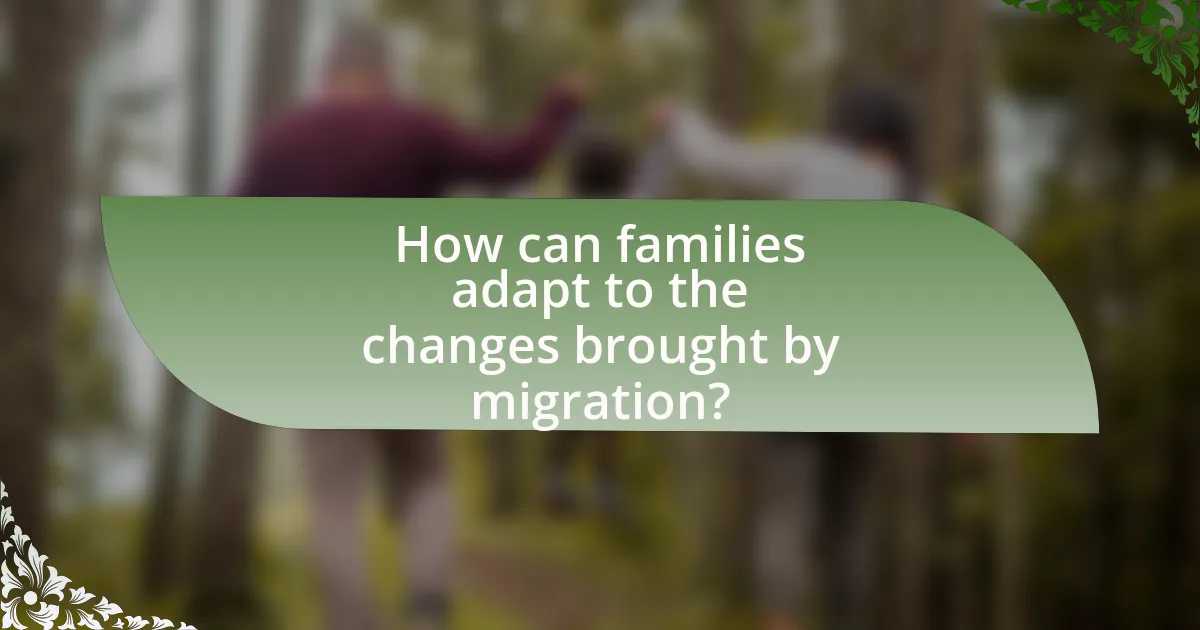
Families can adapt to the changes brought by migration by fostering open communication, embracing cultural integration, and establishing support networks. Open communication allows family members to express their feelings and challenges related to migration, which can strengthen relationships and facilitate understanding. Embracing cultural integration helps families blend their traditions with those of the new environment, promoting a sense of belonging and identity. Establishing support networks, such as connecting with local community organizations or other migrant families, provides emotional and practical assistance, which is crucial for navigating the complexities of migration. These strategies are supported by research indicating that strong family communication and community ties significantly enhance resilience in migrant families (Mazzucato & Schans, 2011, “Transnational Families and the Social Protection of Children”).
What strategies can families use to maintain their lineage identity?
Families can maintain their lineage identity through strategies such as preserving cultural traditions, documenting family history, and fostering intergenerational connections. By actively engaging in cultural practices, families reinforce their unique heritage and values, which is crucial for identity retention. Documenting family history through oral storytelling, written records, or digital archives helps create a tangible connection to the past, ensuring that future generations understand their roots. Additionally, fostering intergenerational connections through family gatherings and shared experiences strengthens bonds and facilitates the transmission of lineage identity, as evidenced by studies showing that families who prioritize these practices report a stronger sense of belonging and identity.
How can cultural traditions be preserved in migrant families?
Cultural traditions can be preserved in migrant families through active engagement in cultural practices, language maintenance, and community involvement. Migrant families can celebrate traditional festivals, prepare traditional foods, and teach their children the customs and values of their heritage. Research indicates that maintaining the native language is crucial, as it fosters a connection to cultural identity and facilitates the transmission of traditions. Additionally, participation in cultural community organizations provides a support network that reinforces cultural practices and offers opportunities for intergenerational sharing of traditions.
What role does technology play in connecting dispersed family members?
Technology plays a crucial role in connecting dispersed family members by facilitating communication and interaction across distances. Tools such as video calls, social media platforms, and messaging apps enable families to maintain relationships despite geographical separation. For instance, a study by Pew Research Center in 2021 found that 97% of adults use mobile phones, which significantly enhances their ability to stay in touch with family members who live far away. This connectivity helps preserve family bonds, share experiences, and support one another emotionally, thereby mitigating the effects of migration on family lineage.
What best practices can families adopt to navigate migration’s impact?
Families can adopt several best practices to navigate the impact of migration effectively. First, maintaining open communication is crucial; it helps family members express their feelings and experiences related to migration, fostering emotional support. Research indicates that families who engage in regular discussions about their migration experiences report higher levels of emotional well-being. Additionally, establishing a strong support network within the community can provide resources and assistance, which is vital for adapting to new environments. Studies show that families with access to community resources, such as local organizations and cultural groups, experience smoother transitions during migration. Lastly, preserving cultural traditions and practices can strengthen family identity and cohesion, which is essential for resilience in the face of change. Families that actively engage in cultural activities often report a stronger sense of belonging and stability.
How can families foster resilience in the face of migration challenges?
Families can foster resilience in the face of migration challenges by establishing strong communication, providing emotional support, and creating a sense of belonging. Strong communication allows family members to express their feelings and concerns, which can alleviate stress and foster understanding. Emotional support, such as encouragement and validation, helps individuals cope with the uncertainties of migration. Additionally, creating a sense of belonging through cultural practices and community engagement reinforces family identity and stability. Research indicates that families who maintain connections to their cultural roots and engage in community activities report higher levels of resilience during migration transitions.
What resources are available for families dealing with migration issues?
Families dealing with migration issues can access various resources, including legal assistance, counseling services, and community support organizations. Legal assistance is often provided by non-profit organizations such as the American Civil Liberties Union, which offers guidance on immigration laws and rights. Counseling services are available through mental health organizations that specialize in trauma and adjustment issues related to migration, such as the National Alliance on Mental Illness. Community support organizations, like local immigrant advocacy groups, provide resources for integration, language classes, and social services, helping families navigate the challenges of migration effectively.
